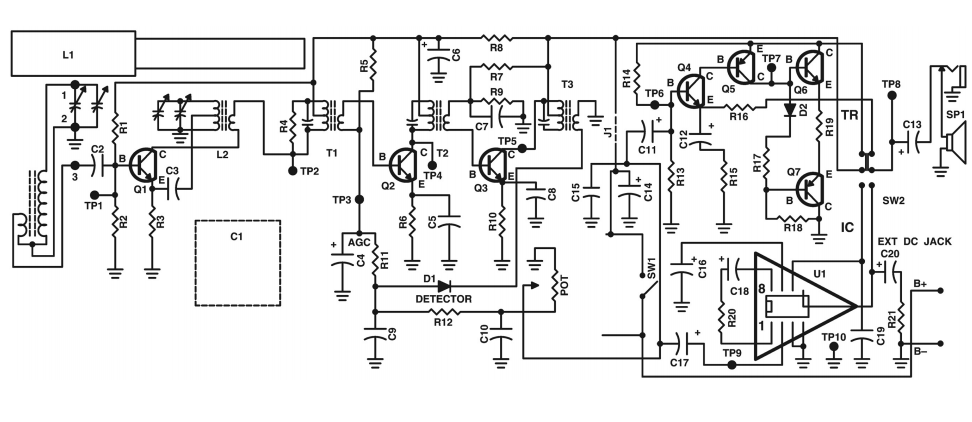Next: Colpitts Oscillators Up: ch4 Previous: Multi-stage Amplification
Differential amplifier amplifies the difference



The two transistors 




 , i.e.,
, i.e.,
 ,
then
,
then
 and the output voltage is
and the output voltage is
 , which
is treated as a reference level corresponding to
, which
is treated as a reference level corresponding to
 .
.
 and
and  become higher/lower,
become higher/lower,  and
and  are driven to go higher/lower, but as their sum
are driven to go higher/lower, but as their sum
 is a
constant, they remain the same and so does the output
is a
constant, they remain the same and so does the output  .
.
 becomes higher but
becomes higher but  remains the same, the following
changes take place:
remains the same, the following
changes take place:
 |
(127) |
 becomes higher but
becomes higher but  remains the same, the following
changes take place:
remains the same, the following
changes take place:
 |
(128) |
 and
and  , but it remains unchanged if both inputs become
higher or lower, i.e., this is a differential amplifier. The output
voltage
, but it remains unchanged if both inputs become
higher or lower, i.e., this is a differential amplifier. The output
voltage  can be further amplified by the subsequent circuit.
can be further amplified by the subsequent circuit.
A simple current source is also shown in the figure. The base voltage







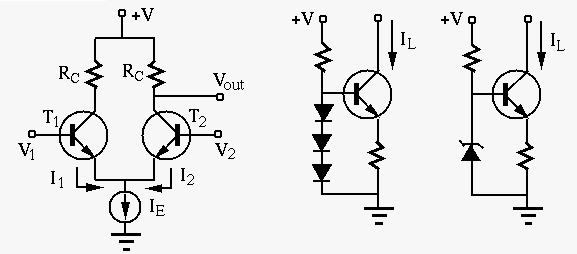
The current mirror circuit shown below is a simple current source
that provides a constant current 

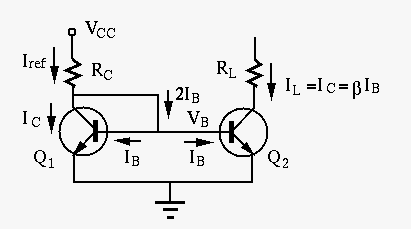
This circuit is composed of two matching transistors 



 |
(129) |
 , and realizing
, and realizing
 ,
we also get
,
we also get
 |
(130) |
 's collector and base are short-circuited,
it behaves like a diode, in terms of the relationship between
's collector and base are short-circuited,
it behaves like a diode, in terms of the relationship between  and
and
 , the voltage across and current through the base-emitter
PN junction:
, the voltage across and current through the base-emitter
PN junction:
 |
(131) |
 is the reverse saturation current of the BE PN-junction,
is the reverse saturation current of the BE PN-junction,  is the thermal voltage. Transistor
is the thermal voltage. Transistor  can be therefore be considered as
a current-voltage converter by which the collector current
can be therefore be considered as
a current-voltage converter by which the collector current
 is converted to an output voltage
is converted to an output voltage  , which is held constant due to
negative feedback loop:
, which is held constant due to
negative feedback loop:
 |
(132) |
 is solely determined by
is solely determined by
 ,
,
 and therefore
and therefore
 will be constant independent
of the load
will be constant independent
of the load  .
.
 and
and  are identical and
are identical and
 , we have
, we have
 and
and
 .
The load current is determined by
.
The load current is determined by  but independent of the load
but independent of the load  :
:
 |
(133) |
 holds,
i.e., both
holds,
i.e., both  and
and  must be working in the linear (active) region
away from either the cutoff or saturation region.
must be working in the linear (active) region
away from either the cutoff or saturation region.
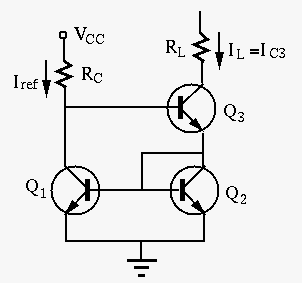
Again, here transistor 






 |
(134) |
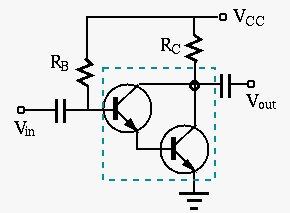
Darlington transistor (Darlington pair) is a compound
structure composed of two transistors, of which the emitter
current of the first transistor becomes the base current of
of the second transistor. The main advantage of the Darlington
transistor is its high current gain

 |
 |
 |
|
 |
 |
 |
|
 |
 |
 |
|
 |
 |
 |
|
 |
 |
 |
 .
.
By properly settng the DC operating point of the transistor circuit, it can be working in any one of the following modes:
 ). The DC operating point is
in the middle of the linear range of the transistor to minimize distortion
(clipping). However, the DC power consumption is maximized even the AC
sinusoidal signal is zero.
). The DC operating point is
in the middle of the linear range of the transistor to minimize distortion
(clipping). However, the DC power consumption is maximized even the AC
sinusoidal signal is zero.
 ),
while it is turned off and consumes no energy for the other half.
),
while it is turned off and consumes no energy for the other half.
 )
)
This circuit can be considered as a class AB amplifier that is
typically used as the last stage of an amplification system, such as
in an op-amp circuit, for power amplification with large current and
low output resistance to drive a heavy load (small 
 , while PNP transistor is cutoff; during the negative half cycle,
the PNP NPN transistor is conductive and draws current from the load
, while PNP transistor is cutoff; during the negative half cycle,
the PNP NPN transistor is conductive and draws current from the load
 , while NPN transistor is cutoff. In either polarity, the output
resistance, the conducting transistor, is small.
, while NPN transistor is cutoff. In either polarity, the output
resistance, the conducting transistor, is small.
 out of phase (e.g., from a transformer, or from the collector and emitter
of the transistor in previous stage). The transistor receiving positive
peak of the input is active and drives current through
out of phase (e.g., from a transformer, or from the collector and emitter
of the transistor in previous stage). The transistor receiving positive
peak of the input is active and drives current through  , with small
output resistance, while the other transistor receiving negative peak
is cutoff (open-circuit). During the next half cycle, the two transistor
switch roles with the conducting transistor drawing current from the load.
, with small
output resistance, while the other transistor receiving negative peak
is cutoff (open-circuit). During the next half cycle, the two transistor
switch roles with the conducting transistor drawing current from the load.
 ,
,
 , and the power consumption is
, and the power consumption is
 ,
even when the AC signal is zero.
,
even when the AC signal is zero.
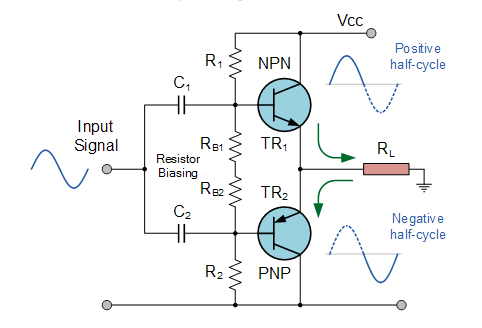
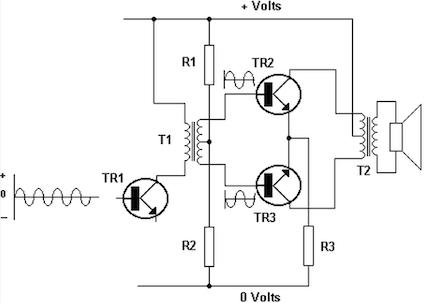
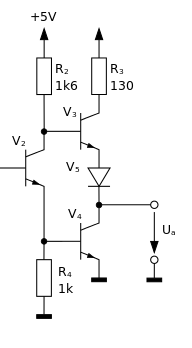
An oscillator is a circuit that receives no input but generates a sinusoidal
output at a desired frequency. A typical oscillator circuit is based on an
active component (a transistor or an op-amp) with positive feedback and an
LC circuit (tank circuit). Initially trigged by switching on the circuit,
the LC circuit starts to resonate at frequency

Specifically, the Hartley and Colpitts oscillators are two typical oscillation
circuits. In either cases, a transistor amplifier is used to receive positive
feedback taken from the LC circuit as a collector impedance 
 and
and  in series. The resonant frequency is
in series. The resonant frequency is
 .
.
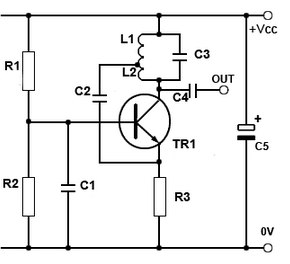
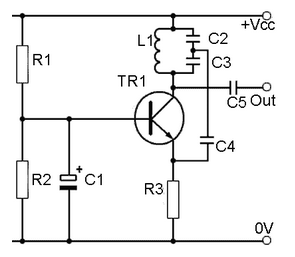
 and
and  in series. The resonant frequency is
in series. The resonant frequency is
 .
.

 |
(135) |
 |
(136) |
When a transistor is used for amplification, its DC operating point of a type A amplifier is typically set in the middle of the load line to maximize the linear dynamic range and thereby minimize the signal distortion (by avoiding the nonlinear region of the transistor circuit).
However, in some applications, the nonlinear behavior of the transistor
circuit is taken advantage of, such as in a frequency mixer, used
for converting all radio frequencies




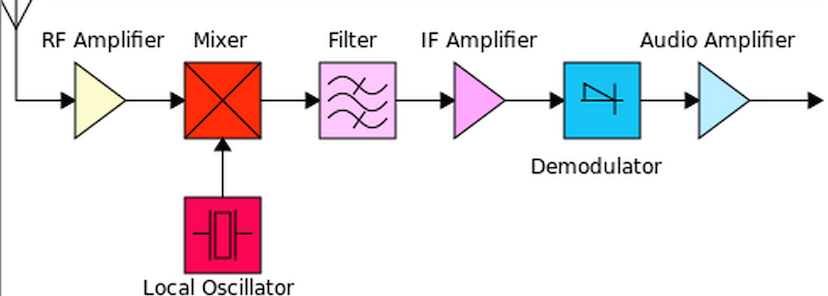
The output current 

 |
(137) |
 i.e. i.e. |
(138) |
 contains
two frequency components, then the output current can be approximated as:
contains
two frequency components, then the output current can be approximated as:
 |
 |
 |
|
 |
 |
||
 |
 |
(139) |
 |
(140) |
 contains many new frequency components in addition
to the two original frequencies
contains many new frequency components in addition
to the two original frequencies  and
and  , including
, including
 ,
,
 ,
,  , and
, and  .
This transistor circuit is therefore called a frequency mixer. By properly
filtering in the circuit following this mixer, one of such frequencies,
such as the difference frequency
.
This transistor circuit is therefore called a frequency mixer. By properly
filtering in the circuit following this mixer, one of such frequencies,
such as the difference frequency
 (the “beat frequency”)
is amplified, while all other frequency components are suppressed.
(the “beat frequency”)
is amplified, while all other frequency components are suppressed.
Note that the specific nonlinear behavior of the circuit is not important, as the Taylor series expansion of any nonlinear function will contain constant, first and second order terms as the exponential function assumed above, and the same frequency components will result.
The circuit diagram of a simple super-heterodyne radio receiver is shown below.
Note that the first transistor is an oscillator that also receives signal from
the LC tuning circuit at the base, i.e., it is also a mixer that mixes two
frequencies. The next two transistors amplify frequency component the signal
from the mixer. Here the frequency



 |
(141) |
